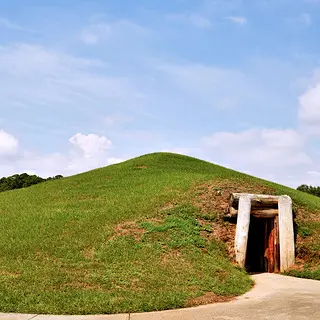
Native American History
Ocmulgee National Historical Park
Lands affiliated with the Ocmulgee National Historical Park have been home to Native Americans for more than 17,000 years. Designated in 1934, the 702-acre Ocmulgee National Historical Park is considered sacred to members of the Muscogee (Creek) Nation as well as to other federally recognized tribes (such as the Cherokee, Chickasaw, Choctaw, and Seminole). The park contains multiple ceremonial mounds from the Mississippian period, including the only spiral staircase mound known to exist in North America.
The Muscogee Creek define the region as “the place where we first sat down,” meaning the place where their ancestors first became a settled agricultural society. With this significance in mind, the National Park Service has determined Ocmulgee eligible for recognition as a Traditional Cultural Property, the first site in the eastern United States to qualify for this designation.

photo by: National Park Service
Attracting 17,000 visitors, Ocmulgee’s Indian Celebration is an annual, 2-day festival which celebrates the history and culture of Ocmulgee’s native people.

photo by: National Park Service
Public pathway leading across Ocmulgee’s rolling landscape towards the Earth Lodge.

photo by: Ken Lund
The Earth Lodge interior measures 42’ in diameter and is within 6” of being a perfect circle. Features include a raised ceremonial bench, individual seats encircling the periphery, and a central fire pit. The clay floor carbon dates to 1015, approximately the time of the Norman Conquest.

photo by: National Park Service
Ocmulgee Museum was constructed in 1951, the park’s Art Moderne headquarters incorporates a museum dedicated to the site’s archaeology and to interpretation of the successive diverse cultures who inhabited the region.

photo by: National Park Service
Expansive, aerial view of the Great Temple Mound.
Over many years, however, the region’s resources have been threatened by urban sprawl, the subdivision of forested tracts, and ownership fragmentation. The river corridor is marked by state-owned wildlife management areas, but in recent years, land sales and relinquished state leases have chipped away at significant acreage, leaving large tracts positioned for residential and commercial development.
Working collaboratively with elected officials at all levels of government, and in consultation with the Creek Nation, the Ocmulgee National Park & Preserve Initiative (ONPPI) re-designated what was once known as Ocmulgee National Monument as the Ocmulgee National Historical Park and expanded Ocmulgee’s current boundaries from 702 acres to approximately 2,800 acres.
In addition, partners encouraged the National Park Service to authorize a Special Resources Study along the 50-mile river corridor connecting Macon and Hawkinsville, Georgia, to determine if the national park unit should be consolidated with adjoining public lands and designated as the Ocmulgee National Park and Preserve.
Advocates also proposed to launch an extensive story-mapping initiative designed to inform the Special Resources Study and to encourage the Park Service to create the Ocmulgee National Park and Preserve. Partners believe there will be a 12-month window of opportunity to pursue the story-mapping effort.
Campaign Goals
- Create the Ocmulgee National Historical Park.
- Complete a story-mapping initiative which examines and illuminates the region’s rich cultural history.
- Designate the Ocmulgee National Park and Preserve.
Opportunity
Protect and expand the Ocmulgee National Monument and its integrated network of culturally affiliated resources.
Support our work to save places that matter.
DonateStay connected with us via email. Sign up today.
Related Stories
-
Where Women Made History U.S. Poet Laureate Joy Harjo: A Life in Four Directions -
We're Saving Places 12 Preservation Wins -
Native American History One Step Closer to Preserving the Story of Georgia's Ocmulgee
Explore More Places
We believe all Americans deserve to see their history in the places that surround us. As a nation, we have work to do to fill in the gaps of our cultural heritage.
Let's Get to Work



